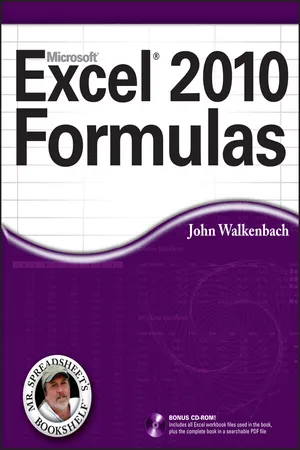Technology & Engineering
Array in Excel
An array in Excel is a collection of values that are stored in a single row or column. It allows for multiple calculations to be performed on the data at once, making it a useful tool for complex calculations and data analysis. Arrays can be created manually or through the use of formulas and functions.
Written by Perlego with AI-assistance
Related key terms
9 Key excerpts on "Array in Excel"
- eBook - ePub
Microsoft Excel Professional 2021 Guide
A Complete Excel Reference, Loads of Formulas and Functions, Shortcuts, and Numerous Screenshots to Become an Excel Expert (English Edition)
- CA Manmeet Singh Mehta(Author)
- 2022(Publication Date)
- BPB Publications(Publisher)
An array formula is a type of formula that performs an operation on multiple values rather than just one. An array formula can produce either a single item or an array of items. In this chapter, we’ll look at what an Excel array formula is and how to properly enter it into our worksheets. Array formulas are extremely powerful, but they were difficult to master until the release of Excel 2021, which made array formulas very simple and understandable to everyone. In this chapter, we will learn how to write dynamic array functions.Arrays in Excel
An array is a collection of multiple items that can be operated on collectively or individually. The items can be text or numbers, and an array can be one or two-dimensional. These dimensions correspond to rows and columns, which means that these values can reside in a single row or column or multiple rows and columns.Arrays in Excel are denoted by curly braces {}. For example, {1,2,3} or {“Silver”;“Gold”;”Diamond”}. The fact that arrays map directly to cell ranges is why they are so useful in Excel. The delimiters between array elements indicate rows and/or columns.Excel has various types of arrays:- A reference array has several cells. For example, a defined name or a cell range.
- A resultant array is an array of elements formed as a result of an array formula.
- An array constant is an array of hard-coded values in a formula.
Array formula
An array formula operates on numerous values instead of just one . Depending on how the formula is written, the result can be one item or an array of items.Therefore, the primary difference between a regular formula and an array formula is that an array formula can process multiple values at once.An array formula can not only deal with several values at once but also return single or multiple values. An array formula’s output can also be an array .Entering array-magic of CSE
Arrays are entered using a combination of the three keys. A regular formula is converted into an array formula by pressing Ctrl + Shift + Enter (CSE) .All Excel array formulas require the combination of Ctrl + Shift + Enter , they are popularly called CSE formulas .Remember: When we finish typing the formula and press Ctrl + Shift + Enter, Excel automatically wraps it in curly braces. We can see the curly braces {} in the formula bar, which indicates that an array formula is present. - eBook - ePub
Ctrl+Shift+Enter Mastering Excel Array Formulas
Do the Impossible with Excel Formulas Thanks to Array Formula Magic
- Mike Girvin(Author)
- 2013(Publication Date)
- Holy Macro! Books(Publisher)
Chapter 2: Introduction to Array Formulas Excel Files To follow along with the examples in this chapter, you can download the accompanying files, as explained in the Introduction. What Is an Array?An array is a collection of two or more items. This is the logical starting point for the book. Everything else follows from this.Array Formula Efficiency Rule 2 An array is a collection of two or more items.The Types of Arrays in ExcelThere are three types of arrays in Excel:- A reference array contains more than one cell. Examples include a range of cells, a worksheet reference, and a defined name.
- An array created by a formula element , also called a resultant array , is an array of items created by the array operation.
- An array constant is an array of values hard coded into a formula.
What Is An Array Formula?Array Formula Efficiency Rule 3 There are three types of arrays in Excel: a reference array, an array created by a formula element, and an array constant. An array formula is a formula that contains an operation (math, comparative, join, or function argument) on an array of items rather than on single items, and, the operation delivers a resultant array of items rather than a single item. This operation is called an array operation and is distinguished from an aggregate operation - eBook - ePub
- John Walkenbach(Author)
- 2011(Publication Date)
- Wiley(Publisher)
Chapter 17: Introducing Array Formulas
In This Chapter
The definition of an array and an array formula One-dimensional versus two-dimensional arrays How to work with array constants Techniques for working with array formulas Examples of multicell array formulas Examples of array formulas that occupy a single cellO ne of Excel’s most interesting (and most powerful) features is its ability to work with arrays in formulas. When you understand this concept, you’ll be able to create elegant formulas that appear to perform spreadsheet magic.This chapter introduces the concept of arrays and is required reading for anyone who wants to become a master of Excel formulas. Chapter 18 continues with lots of useful examples.Understanding Array Formulas
If you do any computer programming, you’ve probably been exposed to the concept of an array. An array is simply a collection of items operated on collectively or individually. In Excel, an array can be one dimensional or two dimensional. These dimensions correspond to rows and columns. For example, a one- dimensional array can be stored in a range that consists of one row (a horizontal array) or one column (a vertical array). A two-dimensional array can be stored in a rectangular range of cells. Excel doesn’t support three-dimensional arrays (but its VBA programming language does).As you’ll see, arrays need not be stored in cells. You can also work with arrays that exist only in Excel’s memory. You can then use an array formula to manipulate this information and return a result. An array formula can occupy multiple cells or reside in a single cell.This section presents two array formula examples: an array formula that occupies multiple cells and another array formula that occupies only one cell.A multicell array formula
Figure 17.1 shows a simple worksheet set up to calculate product sales. Normally, you’d calculate the value in column D (total sales per product) with a formula such as the one that follows, and then you’d copy this formula down the column. - eBook - ePub
Microsoft 365 Excel: The Only App That Matters
Calculations, Analytics, Modeling, Data Analysis and Dashboard Reporting for the New Era of Dynamic Data Driven Decision Making & Insight
- Mike Girvin(Author)
- 2021(Publication Date)
- Holy Macro! Books(Publisher)
Thanks to the new and amazing Excel 365 worksheet formula calculation engine, you do not have to worry about those complexities. You don’t need to use any special keystroke or pre-highlight cells or memorize lists of functions. You can just make an array formula, enter the formula, and everything works.Note: Joe McDaid, the Microsoft program manager for the worksheet calculation engine, says that all formulas are array formulas; it is just that some array formulas deliver only one answer.Everything you learn in this chapter works in the Excel worksheet only. Power Query, Power Pivot, and Power BI also have arrays (called lists or table objects ) and array formulas, but the concepts and mechanics are different from those used with worksheet array formulas.What Is a Worksheet Array?An array is a collection of two or more items. The items, or values, that are allowed in a worksheet array are numbers, text, Boolean values, formula errors, and empty cells.There are several types of worksheet arrays:- Range reference: A range reference is an array that can include a range of cells, an Excel Table element, or a defined name with two or more items. For example, Figure 15.1 shows that the range reference B3:B9 is an array in the array formula =SORT(UNIQUE(B3:B9)).
Figure 15.1 B3:B9 is an array in the array formula shown here.- Array constant: An array constant is an array of column values, row values, or table values that are hard coded into a formula. Figure 15.2 shows the syntax used for array constants. Figure 15.3 shows that the array constant {1,2,3} is an array in the array formula =SUM(LARGE(C3:G3,{1,2,3})).
Figure 15.2 Syntax for array constants and resultant arrays.Figure 15.3 {1,2,3} is an array in the array formula shown here.- Resultant array: A resultant array is an array created by a formula element. For example, Figure 15.4 shows that the formula element LARGE(C3:G3,{1,2,3}) evaluates to the resultant array {169,143,118}, which is used by the SUM function.
Figure 15.4 The formula element LARGE(C3:G3,{1,2,3}) evaluates to the resultant array {169,143,118}.- Spilled array:
- eBook - ePub
- John Walkenbach(Author)
- 2010(Publication Date)
- Wiley(Publisher)
Array Formulas Chapter 14 Introducing Arrays Chapter 15 Performing Magic with Array FormulasPassage contains an image
Chapter 14: Introducing ArraysIn This Chapter• The definition of an array and an array formula• One-dimensional versus two-dimensional arrays• How to work with array constants• Techniques for working with array formulas• Examples of multicell array formulas• Examples of array formulas that occupy a single cellIntroducing Array FormulasOne of Excel's most interesting (and most powerful) features is its ability to work with arrays in a formula. When you understand this concept, you'll be able to create elegant formulas that appear to perform magic. This chapter introduces the concept of arrays and is required reading for anyone who wants to become a master of Excel formulas. Chapter 15 continues with lots of useful examples.If you do any computer programming, you've probably been exposed to the concept of an array. An array is a collection of items operated on collectively or individually. In Excel, an array can be one-dimensional or two-dimensional. These dimensions correspond to rows and columns. For example, a one-dimensional array can be stored in a range that consists of one row (a horizontal array) or one column (a vertical array). A two-dimensional array can be stored in a rectangular range of cells. Excel doesn't support three-dimensional arrays (although its VBA programming language does).As you'll see, though, arrays need not be stored in cells. You can also work with arrays that exist only in Excel's memory. You can then use an array formula to manipulate this information and return a result. An array formula can occupy multiple cells or reside in a single cell.This section presents two array formula examples: an array formula that occupies multiple cells, and another array formula that occupies only one cell. A multicell array formulaFigure 14-1 shows a simple worksheet set up to calculate product sales. Normally, you would calculate the value in column D (total sales per product) with a formula such as the one that follows, and then copy this formula down the column: - eBook - ePub
- John Walkenbach(Author)
- 2013(Publication Date)
- Wiley(Publisher)
Part IV: Array Formulas Chapter 14 Introducing Arrays Chapter 15 Performing Magic with Array FormulasPassage contains an image
Chapter 14: Introducing Arrays In This Chapter • Defining arrays and array formulas • One-dimensional versus two-dimensional arrays • How to work with array constants • Techniques for working with array formulas • Examples of multicell array formulas • Examples of array formulas that occupy a single cellOne of Excel's most interesting (and most powerful) features is its ability to work with arrays in a formula. When you understand this concept, you can create elegant formulas that appear to perform magic. This chapter introduces the concept of arrays and is required reading for anyone who wants to become a master of Excel formulas. Chapter 15 continues with lots of useful examples.Introducing Array FormulasIf you do any computer programming, you've probably been exposed to the concept of an array, which is a collection of items operated on collectively or individually. In Excel, an array can be one-dimensional or two-dimensional. These dimensions correspond to rows and columns. For example, a one-dimensional array can be stored in a range that consists of one row (a horizontal array) or one column (a vertical array). A two-dimensional array can be stored in a rectangular range of cells. Excel doesn't support three-dimensional arrays (although its VBA programming language does).As you'll see, though, arrays need not be stored in cells. You can also work with arrays that exist only in Excel's memory. You can then use an array formula to manipulate this information and return a result. Excel supports two types of array formulas:• Multicell array formulas: - eBook - ePub
- Michael Alexander, Richard Kusleika(Authors)
- 2016(Publication Date)
- Wiley(Publisher)
PART IVArray Formulas- Chapter 14: Introducing Arrays
- Chapter 15: Performing Magic with Array Formulas
Passage contains an image
Chapter 14 Introducing Arrays
In This Chapter- Defining arrays and array formulas
- One-dimensional versus two-dimensional arrays
- How to work with array constants
- Techniques for working with array formulas
- Examples of multicell array formulas
- Examples of array formulas that occupy a single cell
One of Excel’s most interesting (and most powerful) features is its ability to work with arrays in a formula. When you understand this concept, you can create elegant formulas that appear to perform magic. This chapter introduces the concept of arrays and is required reading for anyone who wants to become a master of Excel formulas. Chapter 15, “Performing Magic with Array Formulas,” continues with lots of useful examples.Introducing Array Formulas
If you do any computer programming, you’ve probably been exposed to the concept of an array, which is a collection of items operated on collectively or individually. In Excel, an array can be one dimensional or two dimensional. These dimensions correspond to rows and columns. For example, a one-dimensional array can be stored in a range that consists of one row (a horizontal array) or one column (a vertical array). A two-dimensional array can be stored in a rectangular range of cells. Excel doesn’t support three-dimensional arrays (although its VBA programming language does).As you’ll see, though, arrays need not be stored in cells. You can also work with arrays that exist only in Excel’s memory. You can then use an array formula to manipulate this information and return a result. Excel supports two types of array formulas:- Multicell array formulas:
- eBook - ePub
- Julitta Korol(Author)
- 2019(Publication Date)
- Mercury Learning and Information(Publisher)
7STORING MULTIPLE VALUES IN EXCEL VBA PROGRAMS
A QUICK INTRODUCTION TO WORKING WITH ARRAYSI n previous chapters, you worked with many VBA procedures that used variables to hold specific information about an object, property, or value. For each single value that you wanted your procedure to manipulate, you declared a variable. But what if you have a series of values? If you had to write a VBA procedure to deal with larger amounts of data, you would have to create enough variables to handle all the data. Can you imagine the nightmare of storing in your program currency exchange rates for all the countries in the world? To create a table to hold the necessary data, you’d need at least three variables for each country: country name, currency name, and exchange rate. Fortunately, Visual Basic has a way to get around this problem. By clustering the related variables together, your VBA procedures can manage a large amount of data with ease. In this chapter, you’ll learn how to manipulate lists and tables of data with arrays.UNDERSTANDING ARRAYS
An array is a special type of variable that represents a group of similar values that are of the same data type (String, Integer, Currency, Date, etc.). The two most common types of arrays are one-dimensional arrays (lists) and twodimensional arrays (tables). A one-dimensional array is sometimes referred to as a list. A shopping list, a list of the days of the week, and an employee list are examples of one-dimensional arrays or, simply, numbered lists. Each element in the list has an index value that allows accessing that element. For example, in the following illustration we have a one-dimensional array of six elements indexed from 0 to 5:(0) (1) (2) (3) (4) (5) You can access the third element of this array by specifying index (2). By default, the first element of an array is indexed zero. You can change this behavior by using the Option Base 1 - eBook - ePub
Matlab
A Practical Introduction to Programming and Problem Solving
- Dorothy C. Attaway(Author)
- 2009(Publication Date)
- Butterworth-Heinemann(Publisher)
Chapter 7Data Structures
Cell Arrays and Structures
Contents7.1 Cell Arrays 7.2 StructuresKey Words
data structure structure field database record cell array vector of structures nested structureData structures are variables that store more than one value. In order for it to make sense to store more than one value in a variable, the values should somehow be logically related. There are many different kinds of data structures. We have already been working with one kind, arrays (e.g., vectors and matrices). An array is a data structure in which all the values are logically related in that they are of the same type, and represent in some sense the same thing. So far, that has been true for the vectors and matrices that we have used.A cell array is a kind of data structure that stores values of different types. Cell arrays can be vectors or matrices; the different values are stored in the elements of the array. One very common use of a cell array is to store strings of different lengths.Structures are data structures that group together values that are logically related, but are not the same thing and not necessarily the same type. The different values are stored in separate fields of the structure.One use of structures is to set up a database of information. For example, for a class a professor might want to store information for every student in the class: the student’s name, university ID number, grades on all assignments and quizzes, and so on. In many programming languages and database programs, the terminology is that within a database file, there would be one record of information for each student; each separate piece of information (name, quiz 1 score, etc.) would be called a field of the record. In the MATLAB® software these records are called structs .7.1 Cell Arrays
One type of data structure that MATLAB has but is not found in many programming languages is a cell array
Learn about this page
Index pages curate the most relevant extracts from our library of academic textbooks. They’ve been created using an in-house natural language model (NLM), each adding context and meaning to key research topics.








